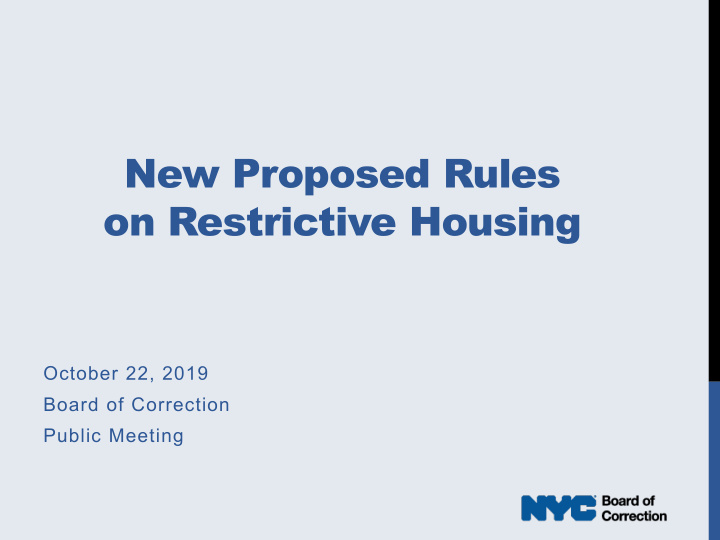



New Proposed Rules on Restrictive Housing October 22, 2019 Board of Correction Public Meeting
WHAT ARE WE PROPOSING? The Board of Correction (the Board) is proposing a new Chapter 6 of its Minimum Standards designed to ensure that people in the Department of Correction’s custody: (1) are placed in restrictive housing in accordance with due process and procedural justice principles; and (2) are confined in the least restrictive setting and for the least amount of time necessary to address the specific reasons for their placement and to ensure their own safety as well as the safety of staff and other people in custody. 2
DEVELOPMENT OF PROPOSED RULES • Ground breaking reforms in 2014-2018 – such as the elimination of punitive segregation (PSEG) for young adults and limitations on the use of PSEG for adults – led to the Department’s development of alternatives to PSEG and alternative strategies to manage its young adult population. • Implementation of these reforms required DOC to seek variances from the Minimum Standards and led to the Board’s imposition of conditions on granting them. • The proposed rules provide a comprehensive approach to restrictive housing and eliminate the need for six long- standing variances, with a total of 30 conditions. 3
DEVELOPMENT OF PROPOSED RULES 2016 Unanimous Board resolution to commence restrictive housing rule making. 2017 Extensive fact-finding by the Board’s ad hoc Committee on Restrictive Housing Rulemaking. 2018-2019 • The Committee maps out the rules. • Detailed outlines and Chapter 6 drafts are shared with DOC and CHS. • Extensive negotiations are held with DOC and CHS. 4
COMPREHENSIVE APPROACH The proposed rules apply to: • Disciplinary Housing (e.g., PSEG I, RHU, PSEG II) • Transitional/Administrative Housing (e.g., ESH, Secure, TRU, and Second Chance) • Structurally Restrictive Housing (e.g., West Facility, MDC, NIC) 5
COMPREHENSIVE APPROACH The proposed rules standardize, across all restrictive housing types: • Procedural due process protections regarding placement • Placement criteria • Exit criteria • Individualized behavior and programming plans • Periodic reviews • Data reporting to ensure compliance 6
HIGHLIGHTS • 30-day PSEG sentence reduced to 15 days • 60-day PSEG sentence for serious assault on staff modified to permit people sentenced to more than 15 days to earn time off for good behavior. • PSEG I exclusions expanded to include people who are: (i) diagnosed with an intellectual disability; and (ii) pregnant, within eight (8) weeks of pregnancy outcome, or are caring for a child in the DOC nursery program. 7
HIGHLIGHTS • Elimination of automatic surcharge for guilty infractions • Placement of people in PSEG within 30 days of adjudication • Disciplinary system plan for young adults that is consistent with the Nunez Consent Judgment 8
HIGHLIGHTS • Increase young adults’ out-of-cell time in transitional/administrative housing from at least 7 to at least 10 hours per day • Elimination of non-individualized use of restraints, such as restraint desks, during lockout in all facility housing units by 2022. Until then: • Weekly periodic reviews • Rebuttal presumption of advancement out of restraint desk 9
Recommend
More recommend